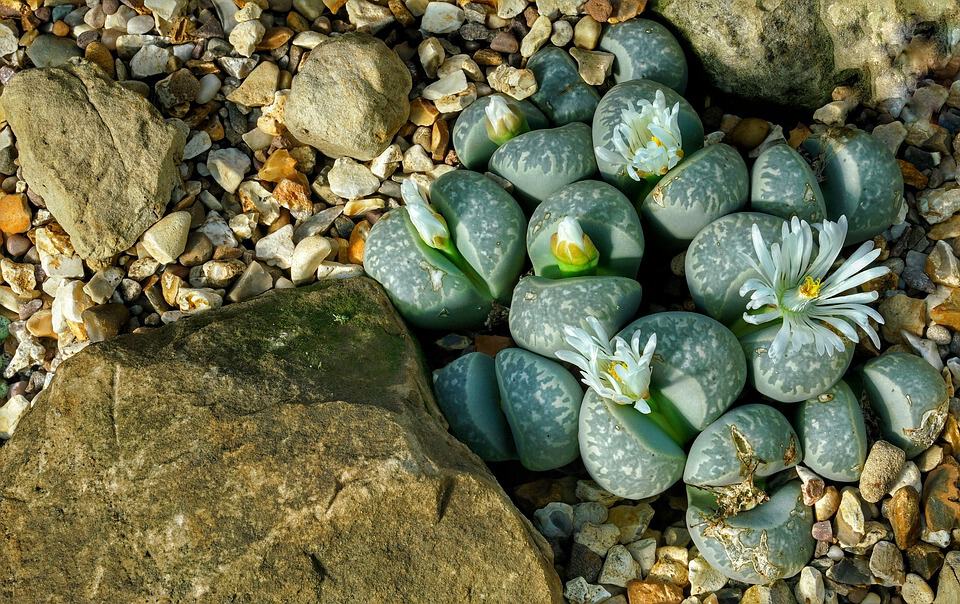
Living Stones Facts
- The highly attention-grabbing term Living Stones serves as the common name for a specific, and truly unique, genus of plants. All known members of this unusual genus evolved quite closely grouped. In fact, all evolved as native to one certain continent.
- The first scientific description of a member of this genus occurred in the year 1811. The groundbreaking scientific discovery occurred entirely accidentally, though. The amazed individual making the discovery was the British botanist William John Burchell.
- Since that time long ago time, however, the fascinating group has expanded comparatively significantly. For the moment, botanists place a total of 37 recognized species exist within the bizarre genus. Even more varieties may be added in the future.
- That’s true because scientists acknowledge that other, unrecognized species potentially exist. These as yet unrecognized varieties likely exist, they recognize, and await discovery. This amazing fact holds true due to the nature of the region it inhabits.
- Some of the species appear to have stable populations, while some do not. The IUCN therefore lists a few of them as Vulnerable. The primary threat that the various species known as Living Stones face consists of the growing danger of climate change.
Related Articles
Living Stones Physical Description
Since the common term Living Stones applies to more than one species, one particular fact remains paramount. That’s the understandable fact that physical differences obviously exist between them. That, however, remains a very basic fact of natural evolution.
All of the various members of the genus still have some basic physical traits in common, though. Firstly, all known individuals within the genus possess one or more pairs of leaves. Secondly, these distinctive leaves have a highly bulbous, almost fused nature to them.
These remarkably evolved leaves also display virtually no stem. In point of fact, the leaves of the different species are also placed directly opposite each other. This part of the differing forms of Living Stones also serves to function as a form of camouflage for it.
Due to this fact, different species show different colors. This allows each to best blend in with its surroundings. That distinction occurs due to the varying natures of the local environment. These colors most commonly include shades of brown, cream, and gray.
- Kingdom: Plantae
- Phylum: Angiosperms
- Class: Eudicots
- Order: Caryophyllales
- Family: Aizoaceae
- Genus: Lithops
Living Stones Distribution, Habitat, and Ecology
Perhaps most notably, the truly incredible genus known as the Living Stones has a fairly moderate habitat range. That’s because all known members of the scientific group live in the same general area. That consists of certain regions of the continent of Africa.
More specifically, the vast majority of its numbers appear in the countries of South Africa, Namibia, and Botswana. Within that range, however, the impressive group of plants displays some versatility. It inhabits a variety of both altitudes and environments.
As a result of this surprising variety, it appears in either, veld, grasslands, or even bare, rocky ground. This marvel of Nature also thrives in a wide range of altitudes. As a result, the amazing plant makes its home in areas ranging from sea level to high in the mountains.
All of the species known as Living Stones do appear to have a preference for very arid climates. Because of this trait, the regions the genus lives in average less than 27.5 in (70 cm) of rain per year. Within these ranges, differing species prefer various temperature ranges.
The members of this genus have become popular as ornamental plants throughout the world. This popularity occurs due to both its novelty and the readily available supply of seeds. This fact does, at least, increase the chance of the survival of various species.
Species Sharing Its Range
Check out our other articles on 6 Mysterious Natural Phenomena, White Spotted Puffer, Maui Dolphin, Lord Howe Island Stick Insect, Olive Ridley Sea Turtle, Indian Bullfrog, Indian Vulture
